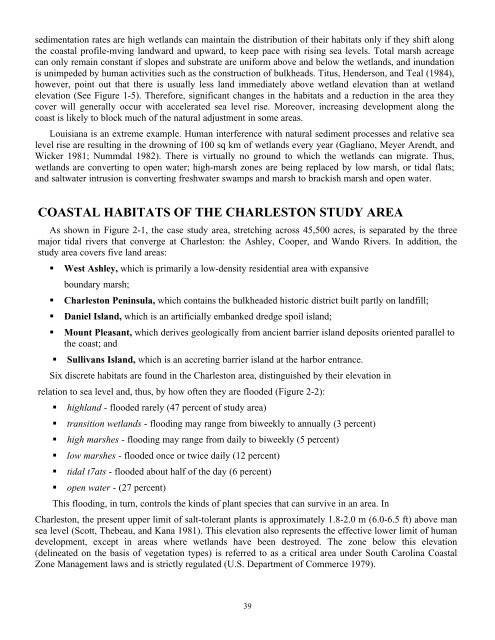Kana et al. 1988. S. Carolina Charleston SLR Case Study
Kana et al. 1988. S. Carolina Charleston SLR Case Study
Kana et al. 1988. S. Carolina Charleston SLR Case Study
You also want an ePaper? Increase the reach of your titles
YUMPU automatically turns print PDFs into web optimized ePapers that Google loves.
sedimentation rates are high w<strong>et</strong>lands can maintain the distribution of their habitats only if they shift <strong>al</strong>ong<br />
the coast<strong>al</strong> profile-mving landward and upward, to keep pace with rising sea levels. Tot<strong>al</strong> marsh acreage<br />
can only remain constant if slopes and substrate are uniform above and below the w<strong>et</strong>lands, and inundation<br />
is unimpeded by human activities such as the construction of bulkheads. Titus, Henderson, and Te<strong>al</strong> (1984),<br />
however, point out that there is usu<strong>al</strong>ly less land immediately above w<strong>et</strong>land elevation than at w<strong>et</strong>land<br />
elevation (See Figure 1-5). Therefore, significant changes in the habitats and a reduction in the area they<br />
cover will gener<strong>al</strong>ly occur with accelerated sea level rise. Moreover, increasing development <strong>al</strong>ong the<br />
coast is likely to block much of the natur<strong>al</strong> adjustment in some areas.<br />
Louisiana is an extreme example. Human interference with natur<strong>al</strong> sediment processes and relative sea<br />
level rise are resulting in the drowning of 100 sq km of w<strong>et</strong>lands every year (Gagliano, Meyer Arendt, and<br />
Wicker 1981; Nummd<strong>al</strong> 1982). There is virtu<strong>al</strong>ly no ground to which the w<strong>et</strong>lands can migrate. Thus,<br />
w<strong>et</strong>lands are converting to open water; high-marsh zones are being replaced by low marsh, or tid<strong>al</strong> flats;<br />
and s<strong>al</strong>twater intrusion is converting freshwater swamps and marsh to brackish marsh and open water.<br />
COASTAL HABITATS OF THE CHARLESTON STUDY AREA<br />
As shown in Figure 2-1, the case study area, str<strong>et</strong>ching across 45,500 acres, is separated by the three<br />
major tid<strong>al</strong> rivers that converge at <strong>Charleston</strong>: the Ashley, Cooper, and Wando Rivers. In addition, the<br />
study area covers five land areas:<br />
West Ashley, which is primarily a low-density residenti<strong>al</strong> area with expansive<br />
boundary marsh;<br />
<strong>Charleston</strong> Peninsula, which contains the bulkheaded historic district built partly on landfill;<br />
Daniel Island, which is an artifici<strong>al</strong>ly embanked dredge spoil island;<br />
Mount Pleasant, which derives geologic<strong>al</strong>ly from ancient barrier island deposits oriented par<strong>al</strong>lel to<br />
the coast; and<br />
Sullivans Island, which is an accr<strong>et</strong>ing barrier island at the harbor entrance.<br />
Six discr<strong>et</strong>e habitats are found in the <strong>Charleston</strong> area, distinguished by their elevation in<br />
relation to sea level and, thus, by how often they are flooded (Figure 2-2):<br />
highland - flooded rarely (47 percent of study area)<br />
transition w<strong>et</strong>lands - flooding may range from biweekly to annu<strong>al</strong>ly (3 percent)<br />
high marshes - flooding may range from daily to biweekly (5 percent)<br />
low marshes - flooded once or twice daily (12 percent)<br />
tid<strong>al</strong> t7ats - flooded about h<strong>al</strong>f of the day (6 percent)<br />
open water - (27 percent)<br />
This flooding, in turn, controls the kinds of plant species that can survive in an area. In<br />
<strong>Charleston</strong>, the present upper limit of s<strong>al</strong>t-tolerant plants is approximately 1.8-2.0 m (6.0-6.5 ft) above man<br />
sea level (Scott, Thebeau, and <strong>Kana</strong> 1981). This elevation <strong>al</strong>so represents the effective lower limit of human<br />
development, except in areas where w<strong>et</strong>lands have been destroyed. The zone below this elevation<br />
(delineated on the basis of veg<strong>et</strong>ation types) is referred to as a critic<strong>al</strong> area under South <strong>Carolina</strong> Coast<strong>al</strong><br />
Zone Management laws and is strictly regulated (U.S. Department of Commerce 1979).<br />
39
















